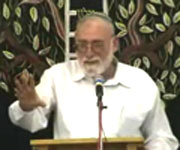Beit Midrash
- Jewish Laws and Thoughts
- Middot - Character Traits
- Personality Development
The Torah study is dedicatedin the memory of
R. Avraham ben-tziyon ben shabtai
2. Evidence of Kedusha's existence from the Talmud
3. Kedusha - The Most Absolute Existence
4. Spatial Kedusha - The Manifestation of Holiness in the Physical World
5. Temporal Kedusha - The Manifestation of Holiness in Time
6. The Kedusha of the Nation of Israel
Holiness Possesses Concrete Existence
Certainly Kedusha (holiness) exists. True, its manifestation is not apparent to the eye, yet even things that man's vision fails to detect exist. For example, though man's soul cannot be seen, it no doubt exists. The soul, in fact, is even more important than the body that it sustains.
Evidence of Kedusha's existence from the Talmud
Rabbi Tzvi Yehudah Kook, zt"l, often brought evidence supporting the assertion that holiness is real and possesses concrete existence from the Talmudic Tractate of Makkot:
"Rabbi Yitzhak said: 'One who plows with a bull which is Pesulei Hamukdashim receives lashes, for, though the bull consists of one body, Scriptures views him as possessing two.' "
What is meant by this puzzling statement? Let's examine it step by step in order to see how it is relevant to our discussion. "Pesulei Hamukdashim" designates an animal which, though it had been consecrated and set aside for the purpose of being sacrificed in the Temple, was later redeemed, i.e. 'un-consecrated'. The law with regard to such an animal is that it is permissible to eat its meat just like any other animal, yet it is forbidden to shave it or to work it, as is the case with holy animals. It is part sacred, and part mundane, part Kadosh (holy), part 'un-Kadosh'. Rabbi Yitzhak informs us that one who plows with such an animal is deserving of lashes. The reason for this is that such plowing constitutes a violation of the prohibition of Kilayim , or plowing with two species of animal, "for though the bull consists of one body, Scripture views him as possessing two" - one possessing Kedusha, and one not. That is, the holy exists as a separate species altogether from the mundane, to the point where Kilayim becomes a factor.
In other words, Kedusha's significance is not confined to the sphere of religious practice alone - we give honor to, and are cautious concerning Kadosh objects though in essence they are no different than other objects. No. Kedusha is an existing reality and the laws that apply to holy objects arise as a result of the existence of this Kedusha.
Kedusha - The Most Absolute Existence
Let us now go a step further in our defining Kedusha. Not only does Kedusha truly exist, but Kedusha's existence is more real and more absolute than any other existence. All of existence issues from a source of absolute Kedusha. It descends in stages from absolute to less absolute, from higher to lower levels of Kedusha, step by step, until finally reaching the level of the mundane. The further and more distanced existence becomes from its source, the less potent it is, the less "real" it is.
Spatial Kedusha - The Manifestation of Holiness in the Physical World
The above applies also concerning God's creation of matter - His creation of the universe. The holiest, most Kadosh place on earth is The Holy Temple in Jerusalem, while the holiest place in the Holy Temple is the Kodesh HaKodeshim - the Holy of Holies. There, in the Holy of Holies sits the Even HaShtiyah - Foundation Stone. The Sages said, "Why is it referred to as the 'Foundation Stone'? - Because from it the world was founded." Nahmanides, in the introduction to his Commentary on the Torah, explains that the Even HaShtiyah was the starting point in the creation of the world. It extended and expanded until it had finally evolved into the entire world. King Solomon, in his great wisdom, knew that, "Out of Zion, the perfection of beauty..." - from Jerusalem the world was founded. The world's essence, and its true starting point derive from the source of Kodesh. Subsequently, the closer something is to Kedusha, the more truly it exists, the more real it is.
Because the Holy of Holies is the stating point in the creation of the world, touching, as it were, that which had existed even before the world came into being, it was home, in the days of the Temple, to a most interesting miracle. "The place of the Ark," said the Sages, "was beyond the realm of space." This assertion is evidenced by the following fact. The Holy of Holies measured twenty cubits by twenty cubits inside. On each side of the Holy Ark, which rested inside the Holy of Holies, there were ten cubits, while the Ark itself occupied the space of two and a half cubits. If the entire space of the Holy of Holies was twenty cubits, how could there have been ten cubits on each side of the Ark? This, indeed, was a miracle befitting such a place, for the Holy of Holies is the bridge between our three dimensional world of space, and a realm beyond space. It therefore possesses both spatial and meta-spatial characteristics at the same time.
Due to the fact that the Holy Temple is a holy place, there are special commandments concerning it and Jerusalem that surrounds it. She is Holier than the rest of the Land of Israel, and therefore possesses special Mitzvoth - for example, certain tithes and sacrifices must be eaten in her midst. It is not the commandments that cause her to be holy; rather, her Kedusha is the cause of these special Mitzvoth. The Land of Israel, too, is holier than the rest of the lands, and therefore has special Mitzvoth attached to her - what we refer to as "Mitzvoth dependent on the Land."
Temporal Kedusha - The Manifestation of Holiness in Time
The same principal holds true with regard to time. The holiest moment in time is the first moment of creation. It, in turn, becomes the source of all time to come. Sabbath is the holiest of all times. Scripture refers to Sabbath, as the "first of the holy convocations (festivals)." She is the heart of the week. There are three days before the Sabbath and three days after the Sabbath, with Sabbath in the middle. Therefore, according to Jewish Law, one who did not perform the Havdala ceremony at the conclusion of Sabbath, marking Sabbaths departure with wine and spices, has until Tuesday to perform it - for up until this point a person is still connected to the holiness of the Sabbath. From Wednesday onward one has already entered the three days preceding the coming Sabbath. The Sages teach us that, in the days to come, the weekdays will be no longer, and everything will simply be one long Sabbath. The time, then, which in our world is beyond time, is the Sabbath. The Sabbath is a "taste of the world to come," a bridge between our world and the world beyond.
Creation, incidentally, began on Sabbath, for concerning the first day our Torah states, "It was evening and it was morning, one day." What is the meaning of, "It was evening?" Why, so long as light had not been created, everything was darkness! The Rabbis explain that at first a bit of light was created, and then immediately darkness appeared - "...it was evening." What was this bit of light that appeared just before the first day of the week? It was the light of Sabbath, which both preceded creation and followed creation. We find, then, that the Sabbath is the source of created time, a holy day, distinct from all other existing days, elevated and more real than any other moment in time. And because Sabbath possesses Kedusha, there are distinct commandments emanating from her.
The Kedusha of the Nation of Israel
Just as Kedusha manifests itself in time and in space, it manifests itself in a people. The People of Israel are more holy than any other people on earth, distinct from all other nations. This is not the merely because of the many commandments incumbent upon them, rather, their nature is essentially and qualitatively different. And, as we have noted, the inherence of Kedusha indicates primacy, a proximity to the beginning of creation. For this reason the People of Israel is referred to as the beginning - "Israel is Kodesh to God, the first of His crops" (Jeremiah 2:3).
Israel, the Nation of Israel, is referred to as God's "first-born". The first-born constitutes a beginning and is Kadosh. The Sages inform us that Israel preceded, as it were, the creation of the world. They constitute the genesis of existence and are therefore Kadosh.
Israel is called the "heart" of the nations. The first stage in man's creation is the formation of the heart, after which the rest of the organs of the body take shape. Similarly, Israel is the first stage in the creation of mankind, and because of their holiness, they have been assigned a unique task, they have been given the Torah and commandments. I am indebted to our Rabbi and Teacher, the late Tzvi Yehudah Kook, from whom I was privileged to receive the essence of the ideas expressed above.
In summary: time, place and people are rooted in Kedusha, for Kedusha is the source of all reality from which the existence of the entire universe is drawn.
The Correct Approach to Jewish Thought
Rabbi Eliezer Melamed | Elul 5760
29. Abstinence Leads to Purity
Rabbi Zalman Baruch Melamed | 5752
51. Sanctity
Rabbi Zalman Baruch Melamed | Monday, 8 Menachem Av 5767























